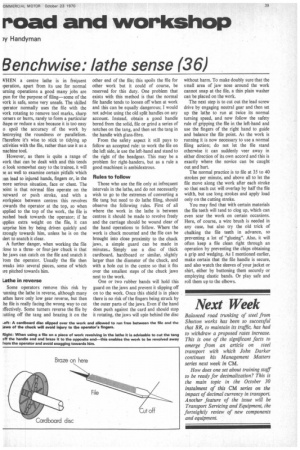road and workshop
Page 41

If you've noticed an error in this article please click here to report it so we can fix it.
w Handyman
Benchwise: lathe sense (36)
WHEN a centre lathe is in frequent iperation, apart from its use for normal urning operations a good many jobs are pun for the purpose of filing—some of the vork is safe, some very unsafe. The skilled iperator normally uses the file with the vork rotating to remove tool marks, sharp :orners or burrs, rarely to form a particular ,hape or reduce a size because it is too easy o spoil the accuracy of the work by iestroying the roundness or parallelism. rherefore it's wise to stick to tidying up ictivities with the file, rather than use it as a nachine tool.
However, as there is quite a range of vork that can be dealt with and this tends
o look somewhat easy to the trainee, it will )e as well to examine certain pitfalls which an lead to injured hands, fingers or, in the nore serious situation, face or chest. The )oint is that normal files operate on the =ward or push stroke, and with a Arorkpiece between centres this revolves ,owards the operator at the top, so when ipplied to the top of the work, the file is )ushed back towards the operator; if he ipplies extra weight on the file, it can :urprise him by being driven quickly and :tongly towards him, unless he is on the dot to snatch it clear.
A further danger, when working the file lose to a threeor four-jaw chuck is that he jaws can catch on the file and snatch it Imm the operator. Usually the file then ireaks into several pieces, some of which ire pitched towards him.
Lathe in reverse
Some operators remove this risk by .unning the lathe in reverse, although many athes have only low gear reverse, but then he file is really facing the wrong way to cut ffectively. Some turners reverse the file by ;utting off the tang and brazing it on the
other end of the file; this spoils the file for other work but it could of course, be reserved for this duty. One problem that exists with this method is that the normal file handle tends to loosen off when at work and this can be equally dangerous; I would not advise using the old split handles on any account. Instead, obtain a good handle bored from the solid, file or grind a series of notches on the tang, and then set the tang in the handle with glass-fibre.
From the safety aspect it still pays to follow an accepted rule: to work the file on the left side, ie use the left-hand and stand to the right of the headgear. This may be a problem for right-handers, but as a rule a good machi nest is ambidextrous.
Rules to follow Those who use the file only at infrequent intervals in the lathe, and do not necessarily wish to go to the extremes of converting a file tang but need to do lathe filing, should observe the following rules. First of all where the work in the lathe is between centres it should be made to revolve freely and the carriage should be wound clear of the hand operations to follow. Where the work is chuck mounted and the file can be brought into close proximity to the chuck jaws, a simple guard can be made in minutes.. Simply use a disc of thick cardboard, hardboard or similar, slightly larger than the diameter of the chuck, and with a hole cut in the centre so that it fits over the smallest steps of the chuck jaws next to the work.
One or two rubber bands will hold this guard on the jaws and prevent it slipping off on to the work. Once this shield is in place there is no risk of the fingers being struck by the outer parts of the jaws. Even if the hand does push against the card and should stop it rotating, the jaws will spin behind the disc without harm. To make doubly sure that the small area of jaw nose around the work cannot snap at the file, a thin plain washer can be placed on the work.
The next step is to cut out the lead screw drive by engaging neutral gear and then set up the lathe to run at twice its normal turning speed, and now follow the safety rule of gripping the file in the left-hand and use the fingers of the right hand to guide and balance the file point. As the work is running it is now necessary to use a normal filing action; do not let the file stand otherwise it can suddenly veer away in either direction of its own accord and this is exactly where the novice can be caught out and hurt.
The normal practice is to file at 35 to 40 strokes per minute, and above all to let the file move along the work after each stroke so that each cut will overlap by half the file width, but use long strokes and apply load only on the cutting stroke.
You may find that with certain materials the file teeth will tend to clog up, which can even scar the work on certain occasions. Here, of course, a wire brush is needed in any case, but also try the old trick of chalking the file teeth in advance, so preventing a lot of "glueing". Also, it will often keep a file clean right through an operation by preventing the chips obtaining a grip and wedging. As I mentioned earlier, make certain that the file handle is secure, and also watch the sleeves of your jacket or shirt, either by buttoning them securely or employing elastic bands. Or play safe and roll them up to the elbows.






































































































